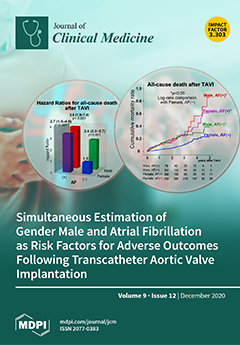This observational, cross-sectional, epidemiological analysis investigated relationships of kidney function to urine calcium and other variables. The analyses targeted two population-based samples of adults (Gubbio study and Moli-sani study:
n = 3508 and 955, respectively). Kidney function was assessed as estimated glomerular filtration
[...] Read more.
This observational, cross-sectional, epidemiological analysis investigated relationships of kidney function to urine calcium and other variables. The analyses targeted two population-based samples of adults (Gubbio study and Moli-sani study:
n = 3508 and 955, respectively). Kidney function was assessed as estimated glomerular filtration rate (eGFR). Calcium/creatinine ratio (Ca/Cr) was used as index of urinary calcium in timed overnight urine under fed condition (Gubbio study), morning urine after overnight fast (Gubbio study), and first-void morning urine (Moli-sani study). Moli-sani study included also data for glomerular filtered calcium load, tubular calcium handling, and serum phosphorus, parathyroid hormone, 1,25-dihydroxyvitamin D, calcium, and 25-hydroxyvitamin D. eGFR positively and independently related to Ca/Cr (
p < 0.001). In multivariate analyses, eGFR lower by 10 mL/min × 1.73 m
2 related to overnight urine Ca/Cr lower by 14.0 mg/g in men and 17.8 mg/g in women, to morning urine Ca/Cr lower by 9.3 mg/g in men and 11.2 mg/g in women, and to first-void urine Ca/Cr lower by 7.7 mg/g in men and 9.6 mg/g in women (
p < 0.001). eGFR independently related to glomerular filtered calcium load (
p < 0.001) and did not relate to tubular calcium handling (
p ≥ 0.35). In reduced eGFR only (<90 mL/min × 1.73 m
2), low urine Ca/Cr independently related to low serum 1,25-dihydroxyvitamin D (
p = 0.002) and did not relate to hyperphosphatemia, high serum parathyroid hormone, or hypocalcemia (
p ≥ 0.14). Population-based data indicated consistent associations of lower kidney function with lower urine calcium due to reduction in glomerular filtered calcium. In reduced kidney function, relative hypocalciuria associated with higher prevalence of low serum 1,25-dihydroxyvitamin D.
Full article






